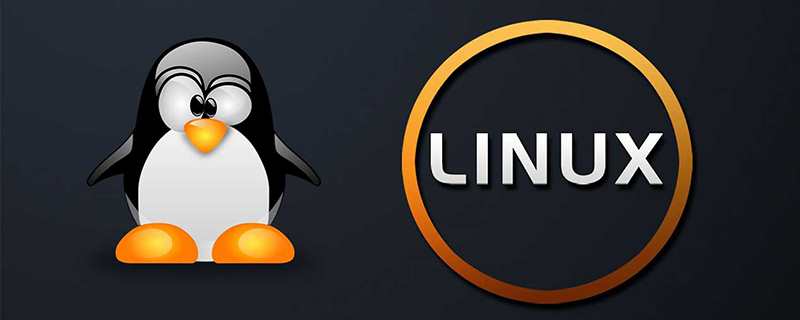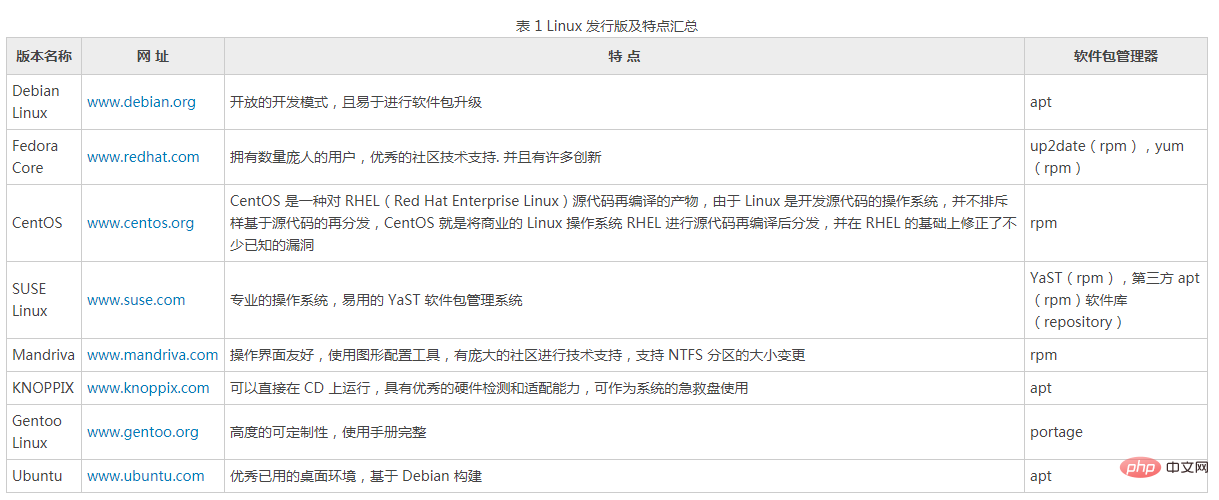 Operation and Maintenance
Operation and Maintenance
 Linux Operation and Maintenance
Linux Operation and Maintenance
 What are the linux distribution versions?
What are the linux distribution versions?
What are the linux distribution versions?

What are the Linux distribution versions?
Linux distributions can be roughly divided into two categories:
● Distributions maintained by commercial companies, represented by the famous Red Hat;
● Releases maintained by community organizations, represented by Debian.
Recommended: "Linux Tutorial"
It's hard to say which one of the many Linux versions is better, each version has its own characteristics . Here are some commonly used Linux distributions.
1) Red Hat Linux
Red Hat (Red Hat) was founded in 1993 and is currently the world’s most senior Linux manufacturer. It is also the most recognized Linux brand.
Red Hat's products mainly include RHEL (Red Hat Enterprise Linux, paid version) and CentOS (community clone version of RHEL, free version), Fedora Core (developed from the Red Hat desktop version, free version ).
Red Hat is the most widely used version of Linux in my country. It has rich information. If you don’t understand something, it’s easy to find someone to ask for advice. Moreover, most Linux tutorials use Red Hat as an example. explained (including this tutorial).
This tutorial takes CentOS, a Linux distribution commonly used by domestic Internet companies in my country, as an example. It is a product recompiled based on the Red Hat Enterprise Linux source code and removed the Red Hat trademark. It is not available for various operations and paid versions. difference and completely free. The disadvantage is that it does not provide technical support to users and does not bear any commercial responsibility. Strong companies can choose the paid version.
2) Ubuntu Linux
Ubuntu is developed based on the well-known Debian Linux. It has a friendly interface, is easy to use, and has very comprehensive hardware support. , is currently the most suitable Linux distribution for desktop systems, and all Ubuntu distributions are available for free.
Mark Shuttleworth, the founder of Ubuntu, is a very legendary figure. After graduating from university, he founded a security consulting company that was acquired for $575 million in 1999, making him the youngest and most promising local millionaire in South Africa. An avid astronomy enthusiast, Mark Shuttleworth spent eight days on the International Space Station aboard a Russian Soyuz spacecraft at his own expense in 2002. Afterwards, Mark Shuttleworth founded the Ubuntu community, established the Ubuntu Foundation on July 1, 2005, and invested $10 million in the foundation. What he saw from space, he said, was the spirit behind his creation of Ubuntu. Today, what he is most passionate about is giving publicity speeches for free and open source Ubuntu.
3) SuSE Linux
SuSE Linux is based on Slackware Linux. It was originally a Linux version released by the German SuSE Linux AG company in 1994. The first version was released in 2004. In the early days, there was only a commercial version. After being acquired by Novell in 2004, the OpenSUSE community was established and launched its own community version of OpenSUSE.
SuSE Linux is more popular in Europe and has many applications in my country. It is worth mentioning that it draws on many characteristics of Red Hat Linux.
SuSE Linux can interact with Windows very easily. The hardware detection is very good. It has a user-friendly installation process and graphical management tools, which are very convenient for end users and administrators.
4) Gentoo Linux
Gentoo was originally created by Daniel Robbins (one of the developers of FreeBSD), and the first stable version was released in 2002 Year. Gentoo is the most complex to install among all Linux distributions. So far, source code packages are still used to compile and install the operating system.
However, it is the easiest to manage version after installation and is also the fastest version to run on the same hardware environment. Since Gentoo 1.0 came out, it has been like a storm, bringing huge surprises to the Linux world, and at the same time attracting a large number of users and developers to embrace Gentoo Linux.
Someone commented on Gentoo: fast, cleanly designed and flexible. It is famous for its high degree of customization (distribution based on source code). Although you can choose pre-compiled packages during installation, most users of Gentoo choose to compile them manually. This is why Gentoo is suitable for veterans with more experience in using Linux.
It should be noted that since compiling software takes a lot of time, if you compile all the software yourself and install larger software packages such as KDE desktop system, it may take a long time. time.
5) Other Linux distributions
In addition to the above four Linux distributions, there are many other versions. Table 1 lists several common Linux distributions. And their respective characteristics:

The above is the detailed content of What are the linux distribution versions?. For more information, please follow other related articles on the PHP Chinese website!

Hot AI Tools

Undresser.AI Undress
AI-powered app for creating realistic nude photos

AI Clothes Remover
Online AI tool for removing clothes from photos.

Undress AI Tool
Undress images for free

Clothoff.io
AI clothes remover

AI Hentai Generator
Generate AI Hentai for free.

Hot Article

Hot Tools

Notepad++7.3.1
Easy-to-use and free code editor

SublimeText3 Chinese version
Chinese version, very easy to use

Zend Studio 13.0.1
Powerful PHP integrated development environment

Dreamweaver CS6
Visual web development tools

SublimeText3 Mac version
God-level code editing software (SublimeText3)

Hot Topics
 deepseek web version entrance deepseek official website entrance
Feb 19, 2025 pm 04:54 PM
deepseek web version entrance deepseek official website entrance
Feb 19, 2025 pm 04:54 PM
DeepSeek is a powerful intelligent search and analysis tool that provides two access methods: web version and official website. The web version is convenient and efficient, and can be used without installation; the official website provides comprehensive product information, download resources and support services. Whether individuals or corporate users, they can easily obtain and analyze massive data through DeepSeek to improve work efficiency, assist decision-making and promote innovation.
 How to install deepseek
Feb 19, 2025 pm 05:48 PM
How to install deepseek
Feb 19, 2025 pm 05:48 PM
There are many ways to install DeepSeek, including: compile from source (for experienced developers) using precompiled packages (for Windows users) using Docker containers (for most convenient, no need to worry about compatibility) No matter which method you choose, Please read the official documents carefully and prepare them fully to avoid unnecessary trouble.
 Ouyi okx installation package is directly included
Feb 21, 2025 pm 08:00 PM
Ouyi okx installation package is directly included
Feb 21, 2025 pm 08:00 PM
Ouyi OKX, the world's leading digital asset exchange, has now launched an official installation package to provide a safe and convenient trading experience. The OKX installation package of Ouyi does not need to be accessed through a browser. It can directly install independent applications on the device, creating a stable and efficient trading platform for users. The installation process is simple and easy to understand. Users only need to download the latest version of the installation package and follow the prompts to complete the installation step by step.
 BITGet official website installation (2025 beginner's guide)
Feb 21, 2025 pm 08:42 PM
BITGet official website installation (2025 beginner's guide)
Feb 21, 2025 pm 08:42 PM
BITGet is a cryptocurrency exchange that provides a variety of trading services including spot trading, contract trading and derivatives. Founded in 2018, the exchange is headquartered in Singapore and is committed to providing users with a safe and reliable trading platform. BITGet offers a variety of trading pairs, including BTC/USDT, ETH/USDT and XRP/USDT. Additionally, the exchange has a reputation for security and liquidity and offers a variety of features such as premium order types, leveraged trading and 24/7 customer support.
 Get the gate.io installation package for free
Feb 21, 2025 pm 08:21 PM
Get the gate.io installation package for free
Feb 21, 2025 pm 08:21 PM
Gate.io is a popular cryptocurrency exchange that users can use by downloading its installation package and installing it on their devices. The steps to obtain the installation package are as follows: Visit the official website of Gate.io, click "Download", select the corresponding operating system (Windows, Mac or Linux), and download the installation package to your computer. It is recommended to temporarily disable antivirus software or firewall during installation to ensure smooth installation. After completion, the user needs to create a Gate.io account to start using it.
 Ouyi Exchange Download Official Portal
Feb 21, 2025 pm 07:51 PM
Ouyi Exchange Download Official Portal
Feb 21, 2025 pm 07:51 PM
Ouyi, also known as OKX, is a world-leading cryptocurrency trading platform. The article provides a download portal for Ouyi's official installation package, which facilitates users to install Ouyi client on different devices. This installation package supports Windows, Mac, Android and iOS systems. Users can choose the corresponding version to download according to their device type. After the installation is completed, users can register or log in to the Ouyi account, start trading cryptocurrencies and enjoy other services provided by the platform.
 gate.io official website registration installation package link
Feb 21, 2025 pm 08:15 PM
gate.io official website registration installation package link
Feb 21, 2025 pm 08:15 PM
Gate.io is a highly acclaimed cryptocurrency trading platform known for its extensive token selection, low transaction fees and a user-friendly interface. With its advanced security features and excellent customer service, Gate.io provides traders with a reliable and convenient cryptocurrency trading environment. If you want to join Gate.io, please click the link provided to download the official registration installation package to start your cryptocurrency trading journey.
 Why does an error occur when installing an extension using PECL in a Docker environment? How to solve it?
Apr 01, 2025 pm 03:06 PM
Why does an error occur when installing an extension using PECL in a Docker environment? How to solve it?
Apr 01, 2025 pm 03:06 PM
Causes and solutions for errors when using PECL to install extensions in Docker environment When using Docker environment, we often encounter some headaches...





